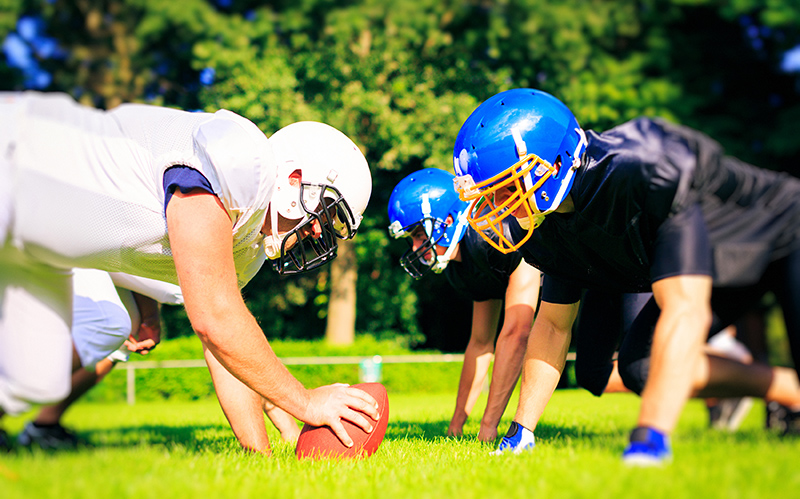
 Judy Li, DO
Judy Li, DO
Pediatric Neurology, Neuroscience Institute
CTE Found in 99 Percent of Deceased NFL Players. This recent news headline may have grabbed your attention. The Journal of the American Medical Association (JAMA) recently published an article showing the results of examining the brains of 202 deceased American football players. This included 111 former NFL players and indeed, 99 percent of them were found to have chronic traumatic encephalopathy (CTE). CTE is a progressive degenerative disease affecting people who have suffered repeated concussions and traumatic brain injury over long periods of time. The most common symptoms include memory loss, mood disturbances, poor judgment, poor balance and onset of early dementia.
As a child neurologist, I am unlikely to encounter a patient with CTE. However, a frequent question I am asked by parents is, “How many is too many concussions?” To begin answering this, let’s go back to the basics.
What causes concussions and what are the symptoms?
A concussion is a type of brain injury that can occur when the head hits an object or a moving object strikes the head. Concussions can also occur when the head experiences a sudden impact without being hit directly such as a blow to the neck or upper bodySports-related concussions are a major public health concern–it is estimated that 1.6-3.8 million injuries occur each year in the United States. A concussion can cause a multitude of symptoms which include:
- Cognitive changes: Poor concentration, slow thinking, memory loss, confusion, loss of consciousness, dazed appearance
- Physical changes: Headache, nausea or vomiting, sensitivity to light or sound, dizziness, slurred speech, blurry vision, changes to balance or coordination
- Mood changes: Depression, anxiety, personality changes, trouble controlling emotions
- Sleep changes: Drowsiness, insomnia, feeling hazy or groggy, frequent awakenings
The symptoms often begin right after injury, but sometimes will not appear until the person starts exercising again. Children often experience concussion symptoms for a much longer time than adults.
Are there sports that put my child at a higher risk of concussion? Concussions occur in many sports, but are most common in high speed contact sports. Football, rugby, hockey and soccer pose the greatest risk. Studies have shown that concussion risk is greater in females than in males playing soccer or basketball. There is not enough evidence to show different risks by gender for other sports. Once someone has experienced a concussion, he or she is at greater risk of having another one.
What should I do if I think my child has had a concussion?
If you suspect a concussion, it’s important to remove the child from play immediately and have him or her evaluated by a licensed healthcare professional. For immediate attention, bring your child to an emergency room or urgent care for an evaluation. If symptoms persist, it is important to follow-up with your child’s pediatrician or primary care provider. In some cases, you may need to be referred to see a neurologist or sports medicine physician who can provide more specialized care for your child’s concussion.
When can my child return to play?
A child can return to play when:
- All symptoms have resolved, especially after medications have been stopped
- Cleared by a licensed professional trained in managing concussion
There is no set time for recovery. The child should avoid any activities that make symptoms worse or increase the risk of a second concussion. The plan should be individualized, so be sure to discuss this plan with your healthcare professional. There is also no evidence that complete “brain rest” is necessary. There is new evidence that too much rest can actually cause more symptoms in teenagers.
Okay, now take a deep breath. The CTE study was done on a selected group of people who volunteered to donate their brain to science. True, it appears that CTE may be related to participation in football, but as a practicing child neurologist, there is still much needed research to be done in this area. One particular area of interest is how concussion affects the young and growing brain differently than a mature adult brain. We must balance the benefits of playing sports with the risk of concussion and other sports-related injuries. Each individual child’s decision to continue to play or not is a personal one, but please know that there is a team of people, parents, athletic trainers and health professionals to help each child make the right choice.
This column is for general information, and any specific questions or concerns regarding this topic should be brought to your physician.


It would be helpful to know the rate of CTEs for deceased men and women for the general population. I believe men would have more than women.
Hi Gerry,
We sent your question to Dr. Li and she responded: CTE has been studied in a variety of sports, including football, soccer and boxing. I do not know of any recent studies comparing men to women. CTE is also is a diagnosis you can confirm only after a person has passed on, so it heavily relies on brain donation efforts to do these type of studies.
I’ve had 7 concussions in my lifetime, all before the age of 18. Is there any evidence that would indicate that a youth could handle this sort of damage better than a mature adult male?
Hi Russ,
We sent your question to Dr. Li and she responded:
This is an excellent point, there was a recent study that suggested NFL players who played tackle football before age 12 were more likely to long-term problems with thinking and behavior issues compared to those who started football later in life. There is likely more research on this coming down the pipeline, but for now, many sports are turning to a non-contact approach until kids reach puberty. Here is a link to the article: http://www.neurology.org/content/early/2015/01/28/WNL.0000000000001358.